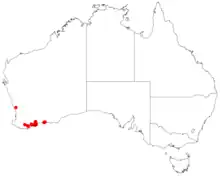| Styphelia blepharolepis | |
|---|---|
| Scientific classification | |
| Kingdom: | Plantae |
| Clade: | Tracheophytes |
| Clade: | Angiosperms |
| Clade: | Eudicots |
| Clade: | Asterids |
| Order: | Ericales |
| Family: | Ericaceae |
| Genus: | Styphelia |
| Species: | S. blepharolepis |
| Binomial name | |
| Styphelia blepharolepis | |
 | |
| Occurrence data from AVH | |
| Synonyms[1] | |
|
Leucopogon blepharolepis (F.Muell.) Benth. | |
Styphelia blepharolepis is a species of flowering plant in the heath family Ericaceae and is endemic to the south-west of Western Australia. It is an erect shrub with sharply-pointed, oblong to lance-shaped leaves and small flowers in racemes of two to five in leaf axils with small bracts and bracteoles about 1 mm (0.039 in) long. The sepals are about 2 mm (0.079 in) long and the petals are joined at the base forming an urn shape about 4 mm (0.16 in) long with lobes longer than the petal tube.[2]
It was first formally described in 1868 by Ferdinand von Mueller in his Fragmenta Phytographiae Australiae.[1] The specific epithet (blepharolepis) means "eye-lash scale", referring to scales near the ovary.[3]
This species occurs in the Esperance plains, Jarrah Forest and Mallee bioregions of the south-west of Western Australia and is listed as "Priority Four" by the Government of Western Australia Department of Biodiversity, Conservation and Attractions,[4] meaning that it is rare or near threatened.[5]
References
- 1 2 3 "Styphelia blepharolepis". Plants of the World Online. Retrieved 5 October 2023.
- ↑ Bentham, George; von Mueller, Ferdinand (1868). Flora Australiensis. Vol. 4. London: Lovell Reeve & Co. p. 213. Retrieved 30 June 2022.
- ↑ Sharr, Francis Aubi; George, Alex (2019). Western Australian Plant Names and Their Meanings (3rd ed.). Kardinya, WA: Four Gables Press. p. 148. ISBN 9780958034180.
- ↑ "Styphelia blepharolepis". FloraBase. Western Australian Government Department of Biodiversity, Conservation and Attractions.
- ↑ "Conservation codes for Western Australian Flora and Fauna" (PDF). Government of Western Australia Department of Parks and Wildlife. Retrieved 30 June 2022.
